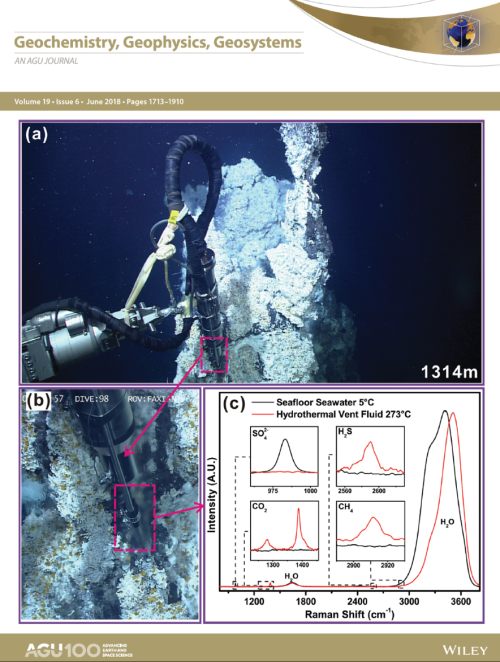[ China Instrument Network Instrument R&D ] Recently, the research team of the Chinese Academy of Sciences Marine Science Research Center, Qi Jun and Li Chaolun team made progress in the in-situ Raman spectroscopy quantitative detection of deep-sea hydrothermal systems. Based on the independent research and development of deep-sea in-situ laser Raman The Raman insertion probe (RiP) performs in-situ Raman spectroscopy on the high-temperature hydrothermal fluid in the hydrothermal zone in the middle of the Okinawa Trough. It is the first time in the world to obtain dissolved carbon dioxide and sulfate ions in high-temperature hydrothermal fluids. In situ concentration. The relevant research results were published in Geochemistry, Geophysics, Geosystems in the form of a cover paper.
Publication cover
As a major discovery of earth sciences in the 20th century, the deep-sea hydrothermal system communicated the exchange of material energy between different layers. In recent years, the physical and chemical properties of high temperature hydrothermal vents and their influence on the ocean environment have become new research hotspots for hydrothermal activities. Temperature, pressure changes, and the effects of seawater mixing can significantly alter the chemical composition or concentration of hydrothermal vent fluids. Although scientists have used fidelity sampling methods for laboratory analysis to obtain relatively close data, they have been unable to obtain due to limitations in sampling methods. Accurate samples of fluid in high temperature hydrothermal vents result in significant differences between the analytical data and the actual data. The research team has overcome the international technical problems of high temperature and high concentration of optical lens attached to the optical system, and successfully developed the world's first high temperature (450 ° C) hydrothermal fluid Raman spectroscopy probe - RiP (Xin Zhang et Al., DSR-I, 2017). Since 2015, the system has relied on the “Science†scientific research vessel and the “Discovery†deep sea cable control submersible (ROV) to in situ the high temperature hydrothermal vents in the Manus hydrothermal zone and the Okinawa Trough hydrothermal zone. Raman spectroscopy detects a large amount of in situ spectral data.
The study is based on the in-situ Raman spectroscopy (up to 273 °C) of three high-temperature hydrothermal vent fluids in the central hydrothermal zone of the Okinawa Trough obtained from the 2016 "Science" hydrothermal cold spring integrated voyage, combined with a large number of high temperature simulation experiments in the laboratory. The established Raman spectroscopic quantitative analysis model of CO2 and SO42- (Lianfu Li, Xin Zhang*, et al., Applied Spectroscopy, 2018; Shichuan Xi, Xin Zhang*, et al., Applied Spectroscopy, 2018) was successfully identified. The concentration of CO2 and SO42- in the hydrothermal vent fluid in the middle of the Okinawa Trough (Lianfu Li, Xin Zhang*, et al., G-cubed, 2018). The study found that the sulfate content as an indicator of the degree of seawater mixing is almost zero in the measured high temperature hydrothermal fluid, which proves that seawater intrusion does not occur in the hydrothermal fluid collected by the in situ Raman detection system. Represents the original hydrothermal fluid effluent. By comparing the CO2 concentration measured by the ROV in the same hot liquid nozzle pressure-sampling sampling method, it is found that the in-situ measurement concentration can be more than three times higher than the test concentration of the pressure-holding sampling laboratory. Based on this achievement, it can be considered that the impact of hydrothermal activities on the global carbon cycle and climate change is likely to be greatly underestimated. This research is of great significance for promoting the application of in-situ spectroscopy in extreme sea environment and helps to re-understand the impact of hydrothermal activity on the global marine environment.
The research was funded by the National Natural Science Foundation of China, the Ocean Pilot Project of the Chinese Academy of Sciences, and the Key Science Research Project of the Chinese Academy of Sciences. Ph.D. student Li Lianfu is the first author of the paper, and researcher Zhang Xin is the author of the communication.
(Original title: In-situ Raman quantitative detection of deep sea high temperature hydrothermal vents has achieved new breakthrough)
Heat Exchanger
Tongxing's most advanced products of copper aluminum fin type condenser and evaporator, which have already been widely used in Commercial Refrigeration, AUTO AC, Commercial & Residential AC . High heat exchange efficiency,automatic process production line, mechanical welding arm, high standard internal cleaness , over 20 models production line, tube pipe covers ( Ñ„5mm, Ñ„6mm, Ñ„7mm, Ñ„7.94mm, Ñ„9.52mm , Ñ„12.7mm.Ñ„15.88mm ). Use high quality aluminum foil and high strength aluminum pipe to straight pulling expanding pipe, to make fins and pipes combine tightly . Composing professional bending machine for molding, no-clean braze technology,high pressure leakage test,fluoride-free clean, degrease painting,nitorgen protection. The All Aluminum Evaporator & condenser has high heat exchange performance , light , less welding points and etc.. Our craft processing of inner cleanness and anti-corrosion is the most advanced over the world . Which is widely applied in HFC,CFC and etc.. refrigerants.
Heat Exchanger
Heat Exchanger,Plate Heat Exchanger,Tubes Copper Heat Exchanger,Air-Conditioner Copper Evaporator
Zhejiang Tongxing Technology Co., Ltd. , https://www.txheatexchanger.com

![<?echo $_SERVER['SERVER_NAME'];?>](/template/twentyseventeen/skin/images/header.jpg)